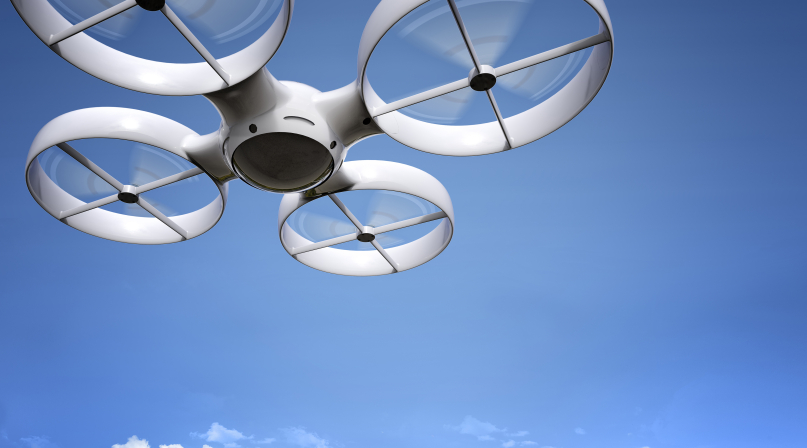Drones: latest technology on county radar
Author

Kevan Stone
Upcoming Events
Related News

In 1783, the first hot-air balloon was launched and mankind could finally touch the sky. 1903 saw the famous Wright Brothers flight and the first helicopter flight soon followed in 1907. It stayed that way for nearly a century. Eventually, we began to hear of the U.S. military using something called a “drone” to conduct reconnaissance and eventually military warfare campaigns across the world. It was indeed a brave new world.
Fast forward to today, and we find ourselves welcoming the first new aerial technology in nearly a century. A technology that anyone can own. While manned aircraft was exorbitantly expensive to purchase, an unmanned aerial system or UAS — AKA “drone” — is not. While this brings a wealth of opportunity for local governments, it also brings with it many new challenges.
Counties have been using drone technology for public safety and infrastructure inspection. Going where man cannot without danger is a vital resource local governments have been quick to embrace.
Instead of asking someone to enter a burning building to search for endangered citizens or asking a county engineer to strap on a harness and check out that bridge, drones can perform this task just as well with no risk of injury.
Up until 2014, approximately 430,000 drones were sold to U.S. consumers. But the market has taken off since then, In 2016, more than 1 million drones were purchased. Chances are, your neighbor or relative owns a drone.
The FAA, cognizant of the rapid expansion of this technology, issued a formal rule in June 2016 regarding drone operations, known as Part 107.
It detailed what drone pilots can or cannot do, such as stating the pilot must be able to see the drone at all times during flight (a visual line of sight), mandating flights can only take place during daylight and designating a maximum speed and altitude, among many others. While released in the name of safety, Part 107 does not answer all concerns posed by county government.
In August 2016, the FAA announced it was creating a Drone Advisory Committee. This committee would officially provide recommendations to the FAA for future regulations and rulemaking. With over 400 applicants, NACo was successful in having one of its own, former Riley County, Kan. commissioner Robert Boyd, appointed to this committee. Its members — including the drone industry, drone technology, federal advocacy and other stakeholders — began meeting in October 2016.
Privacy, governance and federal pre-emption are issues that matter most to county government. Since its inception, the FAA has controlled the skies, from the blade of grass in one’s backyard, to the heavens.
While this has held true for manned aircraft, local governments have had some control in terms of ordinances and laws controlling certain aspects of flights. For example, while local government cannot claim jurisdiction of aircraft flight, it can control where that aircraft takes off from and can control the times of day when takeoff and landing are permitted.
No-fly zones, while federally regulated, have been requested by local governments for sensitive infrastructure and special events. The same principle should apply to drone flight, where the ease of access is much simpler since anyone can walk into a store and buy a drone.
County governments, while proponents of drone technology, are on the front line of responding to UAS issues, being responsible for certain enforcement.
While not specifically mandated by the FAA, law enforcement must attend to laws being broken, whether they be with a car, bike or drone. Airports must rely on law enforcement to ensure drones do not veer into takeoff and landing approaches and protected airspace.
Local police must take the call when privacy is invaded. It is for these and many other reasons that local governments must be actively involved with federal stakeholders as these laws formulate.
As part of the NACo Transportation and Infrastructure Policy Steering Committee’s goals for 2017, Committee Chairman Peter McLaughlin, Hennepin County, Minn., has planned a robust educational program for members to familiarize themselves with drone technology.
At the 2017 NACo Legislative Conference in Washington, D.C., committee members will hear from the FAA and other private stakeholders to gain a clearer understanding of what drones can do, and how they can best use today’s technology and policy to better protect their constituents.
Steering committee meetings are open to all conference attendees.
While everyone agrees drones are here to stay, local government’s role will continue to be of the utmost importance in policy implementation. Through education and collaboration with federal stakeholders, an environment that protects the public while allowing UAS enthusiasts to safely control their craft, can be reached.
Attachments
Related News

U.S. House of Representatives passes SPEED Act and other permitting reform bills
On December 18, the U.S. House of Representatives passed the SPEED Act (H.R. 4776). The SPEED Act would strengthen county involvement in decision-making and make needed commonsense reforms to the federal environmental review process.

Counties and Railroads: Shared Priorities for the Next Surface Transportation Bill
County leaders from across the country have a vital opportunity to ensure their infrastructure priorities are front and center.

House lawmakers introduce bipartisan legislation to support World Cup local transportation needs
On December 2, U.S. Reps. Rick Larsen (D-Wash.-02) and Burgess Owens (R-Utah-04) introduced the Transportation Assistance for Olympic and World Cup Cities Act (H.R.6348), a bipartisan effort to strengthen local transportation systems in communities preparing to host major international sporting events